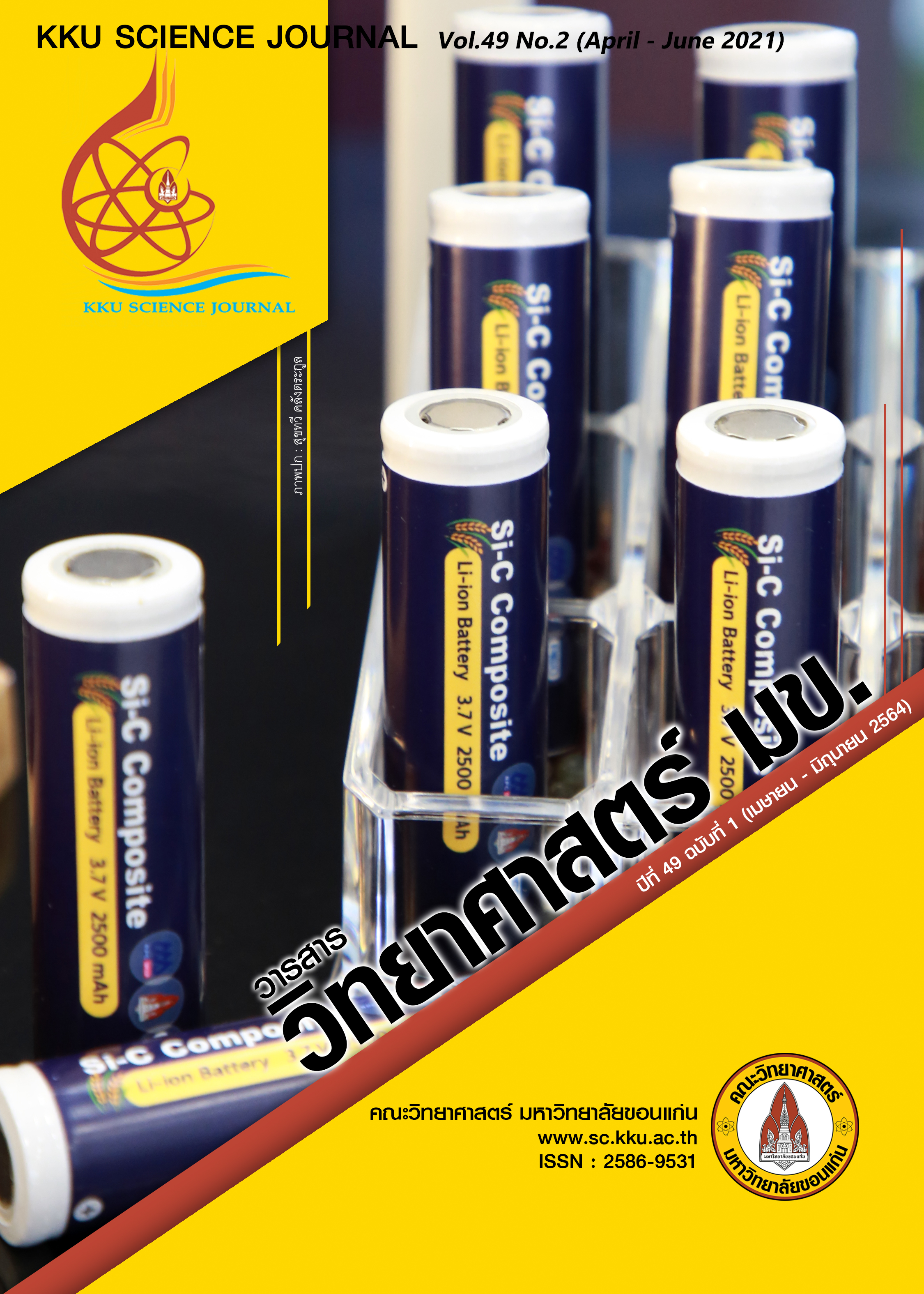Fabrication of CH3NH3Pb1-xGexBr2xI3-2x Perovskite Films as Light Absorber in Carbon-Based Hole-Transporting-Layer-Free Perovskite Solar Cells
Main Article Content
Abstract
In this research, CH3NH3Pb1-xGexBr2xI3-2x perovskite films were prepared by a hot-casting method with 4 different GeBr2 concentrations (x = 0, 1/128, 2/128 and 3/128). The absorbance spectra of CH3NH3Pb1-xGexBr2xI3-2x at x = 2/128 has the highest intensity, and the energy band gap of all CH3NH3Pb1-xGexBr2xI3-2x films is approximately 1.60 eV. SEM images of all perovskite films represent the continuous and smooth perovskite film covering entire titanium dioxide (TiO2) surface. The CH3NH3Pb1-xGexBr2xI3-2x perovskite films were used as the light absorption layer in carbon-based hole – transport – layer – free (HTL) perovskite solar cells (PSCs). The performance of carbon-based HTL – free CH3NH3Pb1-xGexBr2xI3-2x PSCs in the first day was 3.97%, 3.37%, 2.96% and 2.54% for x = 0, 1/128, 2/128 and 3/128, respectively. The efficiency of the solar cell devices increased significantly to 5.33%, 4.33%, 5.90% and 5.96% for x = 0, 1/128, 2/128 and 3/128, respectively, after 1,000 hr.
Article Details

This work is licensed under a Creative Commons Attribution-NonCommercial-NoDerivatives 4.0 International License.
References
Chen, Z., Turedi, B., Alsalloum, A. Y., Yang, C., Zheng, X., Gereige, I., AlSaggaf, A., Mohammed, O. F. and Bakr, O. M. (2019). Single-Crystal MAPbI3 Perovskite Solar Cells Exceeding 21% Power Conversion Efficiency. ACS Energy Letters 4(6): 1258-1259.
Chiao, G. H., Li, L. C., Shellaiah, M. and Sun, K. W. (2019). Improved morphological characteristics and electronic properties of MAPbI3 thin film with multiple methylamine spray treatments. Organic Electronics 78: 105556.
Gao, C., Liu, J., Liao, C., Ye, Q., Zhang, Y., He, X., Guo, X., Mei, J. and Lau., W. (2015). Formation of organic–inorganic mixed halide perovskite films by thermal evaporation of PbCl2 and CH3NH3I compounds. RSC Advances 5: 26175-26180.
Johanssona, M. B., Xieb, L., JoKima, B., Thyrc, J., Kandraad, T., Johanssona, E. M. J., Göthelide, M., Edvinssonc, T. and Boschloo G. (2020). Highly crystalline MAPbI3 perovskite grain formation by irreversible poor-solvent diffusion aggregation, for efficient solar cell fabrication. Nano Energy 78: 105346.
Kojima, A., Teshima, K., Shirai, Y., and Miyasaka, T. (2009). Organometal Halide Perovskites as Visible-Light Sensitizers for Photovoltaic Cells. Journal of American Chemistry Society 131(17): 6050-6051.
Kopacic, I., Friesenbichler, B., Hoefler, S. F., Kunert, B., Plank, H., Rath, T. and Trimmel, G. (2018). Enhanced Performance of Germanium Halide Perovskite Solar Cells through Compositional Engineering. ACS Applied Energy Mater 1(2): 343–347.
Krishnamoorthy, T., Ding, H., Yan, C., Leong, W. L., Baikie, T., Zhang, Z., Sherburne, M., Li, S., Asta, M., Mathews, N. and Mhaisalkar, S. G. (2015). Lead-free Germanium Iodide Perovskite Materials for Photovoltaic Application. Journal of Materials Chemistry A 3: 23829-23832.
Lakhdar N. and Hima A. (2019). Electron transport material effect on performance of perovskite solar cells based on CH3NH3GeI3. Optical Materials 99: 109517.
Liu, F., Ding, C., Zhang, Y., Kamisaka, T., Zhao, Q., Luther, J. M., Toyoda, T., Hayase, S., Minemoto, T., Yoshino, K., Zhang, B., Dai, B., Jiang, J., Tao, S. and Q. Shen, Q. (2019). GeI2 Additive for High Optoelectronic Quality CsPbI3 Quantum Dots and Their Application in Photovoltaic Devices. Chemistry of Materials 31(3): 798–807.
Mali, S. S., Patil, J. V., and Hong, C. K. (2020). Making air-stable allinorganic perovskite solar cells through dynamic hotair. Journal Nano Today 33: 100880.
Mateen, M., Arain, Z., Liu, X., Liu, C., Yang, Y., Ding, Y., Ma, S., Ren, Y.-K., Wu, Y., Tao, Y., Shi, P. and Dai, S. (2019). Highperformance mixed-cation mixed-halide perovskite solar cells enabled by a facile intermediate engineering technique. Journal of Power Sources 448: 227386.
Pitchaiya, S., Eswaramoorthy, N., Natarajan, M., Santhanam, A., Asokan, V., Ramakrishnan, V. M., Rangasamy, B., Sundaram, S., Ravirajan, P., and Velauthapillai, D. (2020). Perovskite Solar Cells: A Porous Graphitic Carbon-based Hole Transporter/Counter Electrode Material Extracted from an Invasive Plant Species Eichhornia Crassipes. Scientific Reports 10: 6835.
Sa, R., Zha, W., Yuan, R. and Chen, J. (2020). Exploring electronic and optical properties of Ge-based perovskites under strain: Insights from the first-principles calculations. Spectrochimica Acta Part A: Molecular and Biomolecular Spectroscopy 229: 118013.
Song, Z., Watthage, S. C., Phillips, A. B. and Heben, M. J. (2016). Pathways toward high-performance perovskite solar cells: review of recent advances in organometal halide perovskites for photovoltaic applications. Journal of Photonics for Energy 6(2): 022001-022023.
Sun, P. P., Li, Q. S., Feng, S. and Li, Z. S. (2016). Mixed Ge/Pb Perovskite Light Absorbers with an Ascendant Efficiency Explored from Theoretical View. Physical Chemistry Chemical Physics 18: 14408-14418.
Tai, E. G., Wang, R. T., Chen, J. Y. and Xu, G. (2019). A Water-Stable Organic-Inorganic Hybrid Perovskite for Solar Cells by Inorganic Passivation. Crystals 9(2): 83


